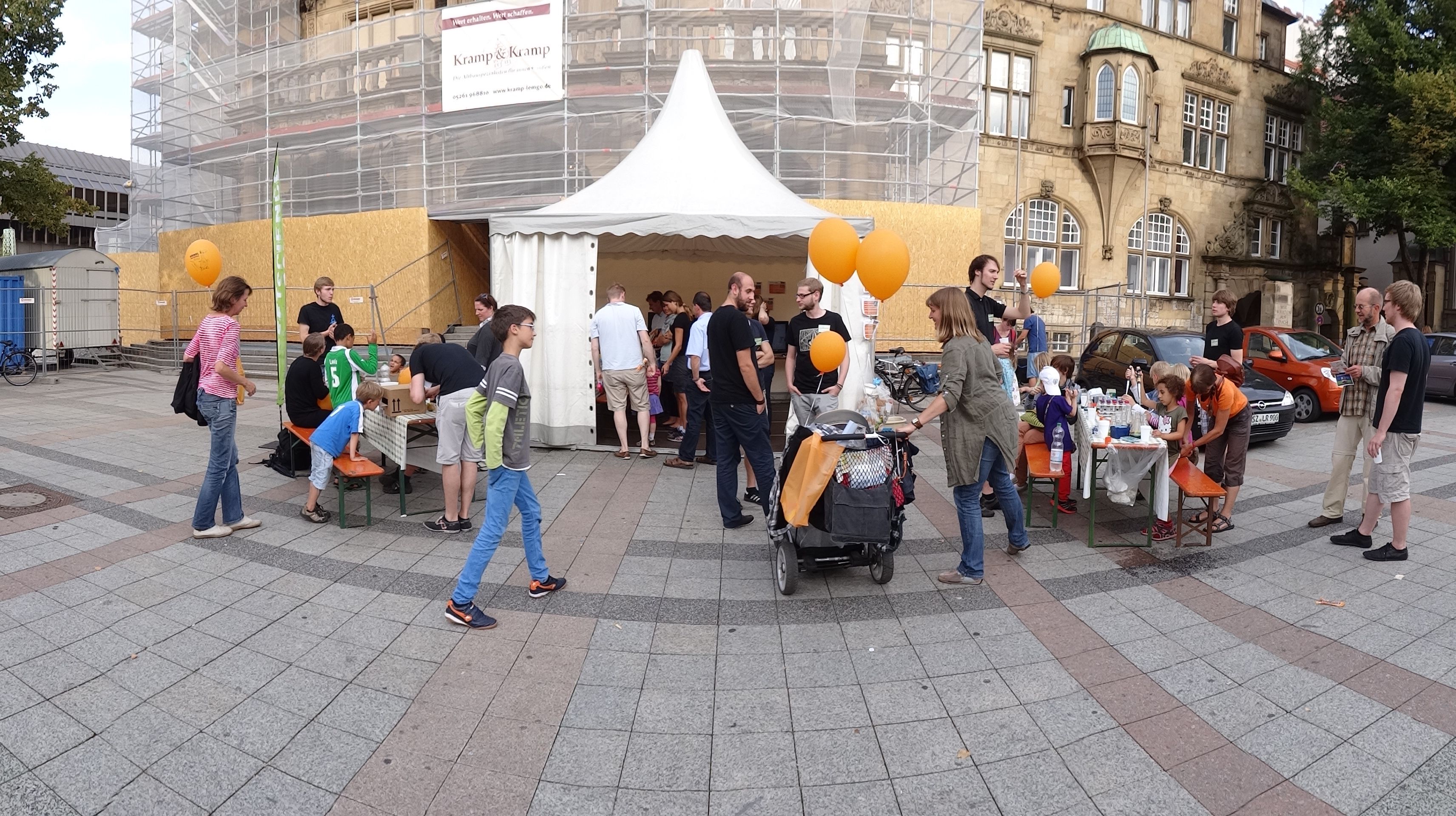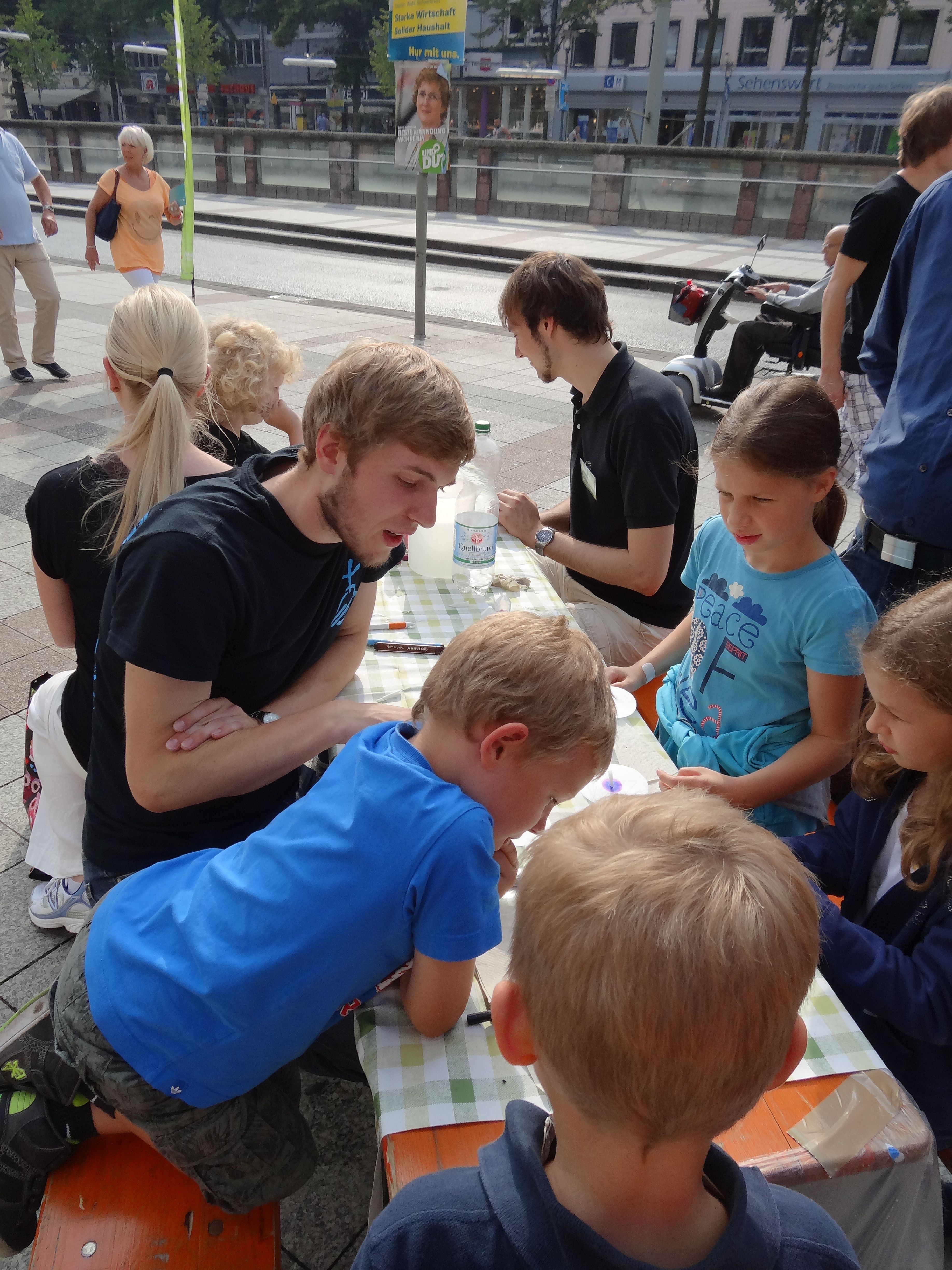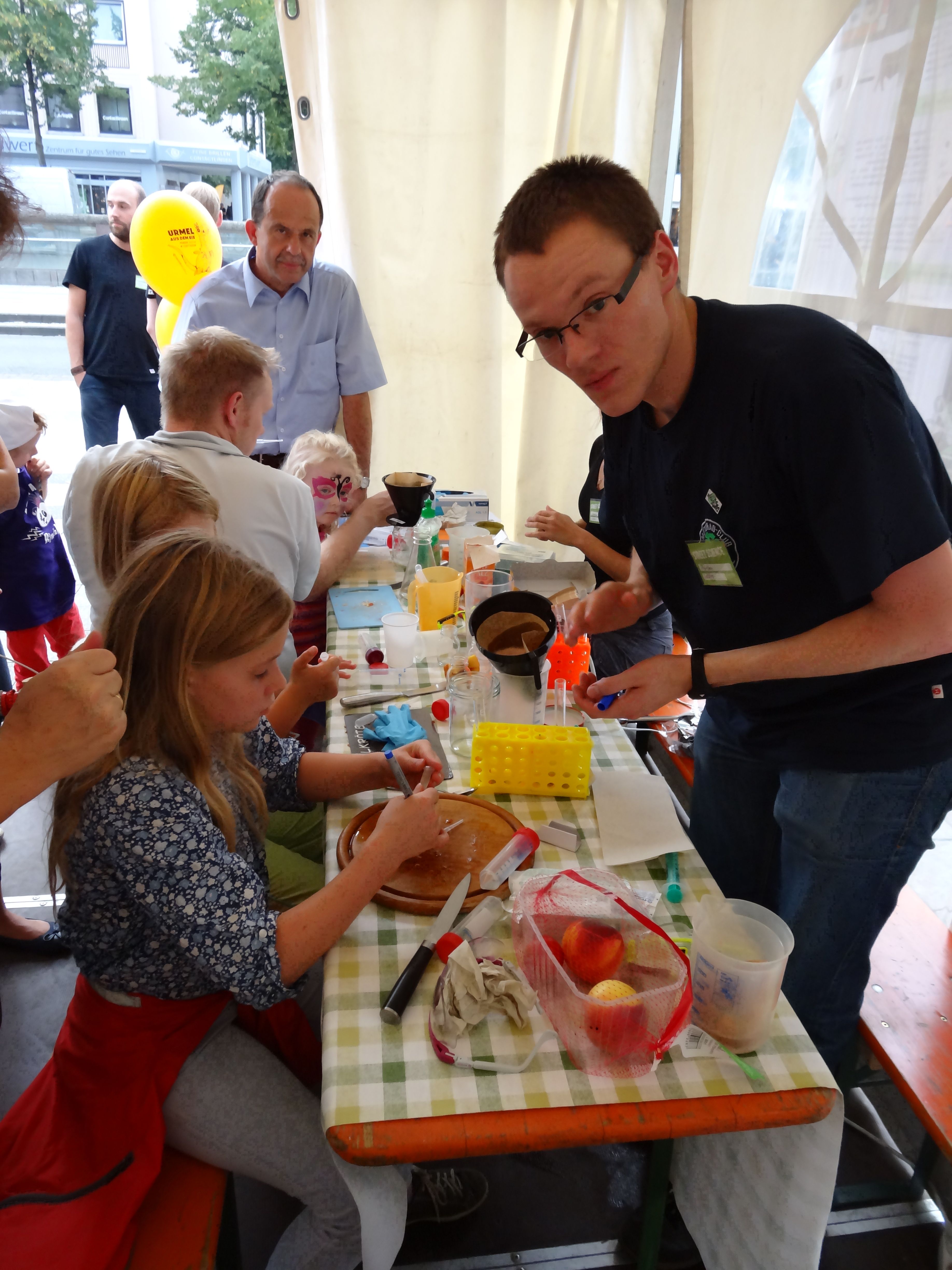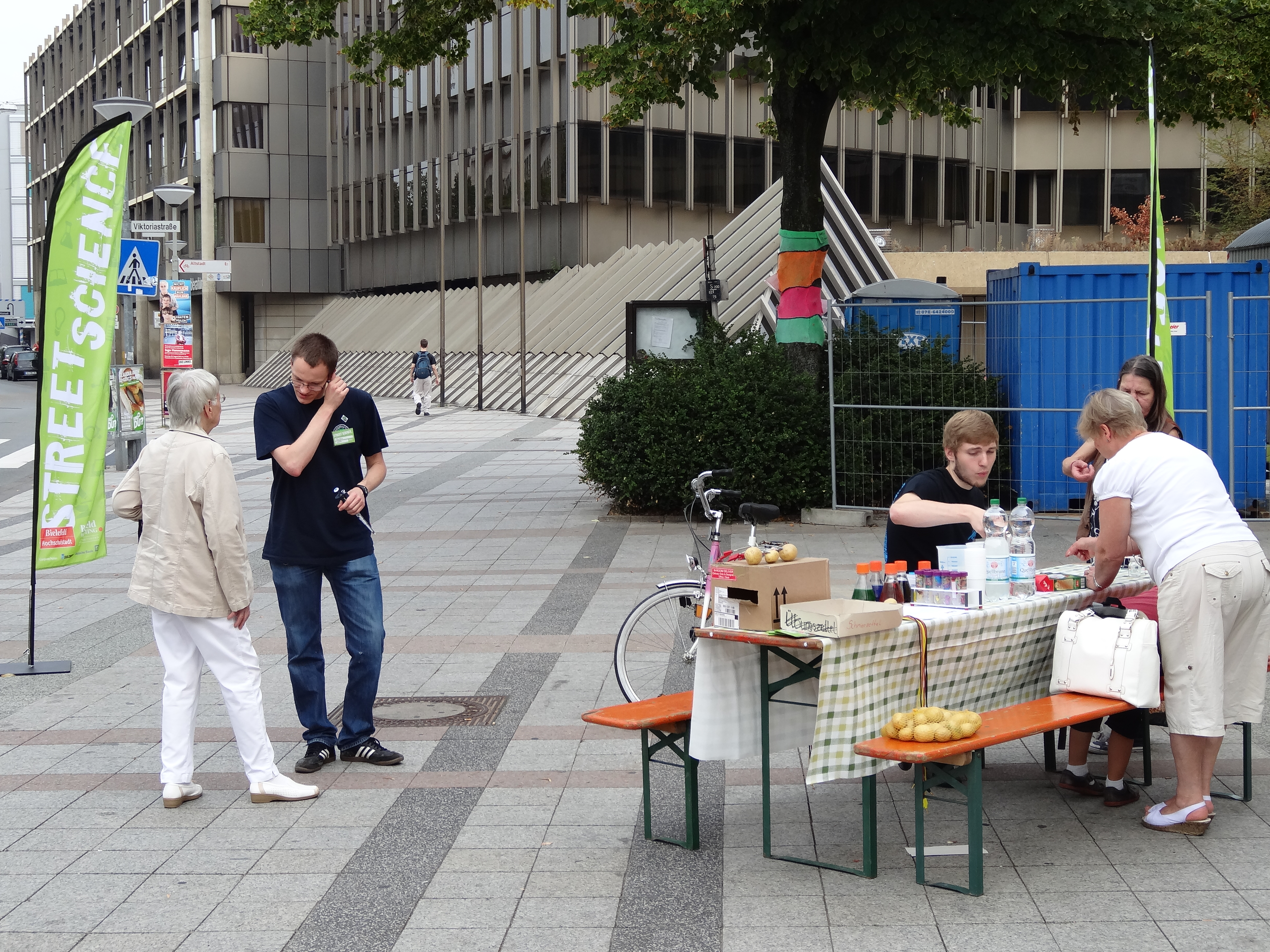Team:Bielefeld-Germany/Human Practice/Day of Synthetic Biology
From 2013.igem.org
| (16 intermediate revisions not shown) | |||
| Line 9: | Line 9: | ||
<html> | <html> | ||
<style> | <style> | ||
| + | |||
#globalwrapper ul {padding-left:40px; padding-right:40px;} | #globalwrapper ul {padding-left:40px; padding-right:40px;} | ||
#globalwrapper #rightcol ul {padding-left:0px; padding-right:0px;} | #globalwrapper #rightcol ul {padding-left:0px; padding-right:0px;} | ||
| + | |||
| + | #globalwrapper div.floatleft{margin-left:0px; margin-right:20px;} | ||
h2,h3,h4{clear:both;} | h2,h3,h4{clear:both;} | ||
#globalwrapper h4{color:#ff6600; padding-left:20px;} | #globalwrapper h4{color:#ff6600; padding-left:20px;} | ||
#globalwrapper div.thumb.tleft{margin-left:20px; margin-right:20px; clear:both;} | #globalwrapper div.thumb.tleft{margin-left:20px; margin-right:20px; clear:both;} | ||
| + | #globalwrapper div.floatleft{margin-left:20px; margin-right:20px;} | ||
#globalwrapper ul {clear:both;} | #globalwrapper ul {clear:both;} | ||
| Line 24: | Line 28: | ||
#globalwrapper p{padding-left:0px; padding-right:40px;} | #globalwrapper p{padding-left:0px; padding-right:40px;} | ||
#globalwrapper .bigbutton p{padding-left:5px; padding-right:5px; padding-top:2px;} | #globalwrapper .bigbutton p{padding-left:5px; padding-right:5px; padding-top:2px;} | ||
| - | |||
| - | .bigbutton{width: | + | .bigbutton{width:150px; height:50px; line-height:50px; font-size:1.2em; margin-right:10px; display:table;} |
.bigbutton a{display:block; height:100%;} | .bigbutton a{display:block; height:100%;} | ||
| Line 39: | Line 42: | ||
box-shadow:0px 0px 2px 0px grey; | box-shadow:0px 0px 2px 0px grey; | ||
padding:0px 20px; | padding:0px 20px; | ||
| + | |||
| + | |||
| + | .bubble-left{} | ||
| + | .bubble-right{margin-left:100px;} | ||
| + | |||
</style> | </style> | ||
</html> | </html> | ||
| - | <div id=globalwrapper style="padding-left:20px; padding-right:20px | + | <div id=globalwrapper style="padding-left:20px; padding-right:20px"> |
| - | <div id="leftcol" style="width: | + | <div id="leftcol" style="width:750px; float:left; overflow:auto;"> |
<html> | <html> | ||
| Line 75: | Line 83: | ||
| - | ==The | + | ==The Event== |
<p align="justify"> | <p align="justify"> | ||
Together with the iGEM teams from Bonn, Freiburg, Munich, Marburg and Tübingen, we decided to organize a nation-wide event in order to promote Synthetic Biology, the iGEM competition and, of course, our individual projects. | Together with the iGEM teams from Bonn, Freiburg, Munich, Marburg and Tübingen, we decided to organize a nation-wide event in order to promote Synthetic Biology, the iGEM competition and, of course, our individual projects. | ||
We picked September 7<sup>th</sup> for this “SynBio Day”, when every participating team set up a booth in their respective home town. In Bielefeld, we set up a booth in front of our town hall. There, we put up posters explaining the basics of Synthetic Biology, as well as our microbial fuel cell project. | We picked September 7<sup>th</sup> for this “SynBio Day”, when every participating team set up a booth in their respective home town. In Bielefeld, we set up a booth in front of our town hall. There, we put up posters explaining the basics of Synthetic Biology, as well as our microbial fuel cell project. | ||
| - | A microscope, connected to a TV, enabled our visitors to examine appearance and movement of different microorganisms. To entertain and educate our young attendants, we also prepared several different experiments and games. We let them use pipettes to mix different kinds of food coloring in well plates. This allowed them to get a first impression of one of the aspects of labwork. With filter paper, they were able to do simple chromatography experiments with different kinds of felt pens/markers. We guided children through DNA isolation experiments using fruits and simple household materials. The isolated DNA was filled into small reaction tubes and sealed so that the children could take their self-extracted DNA home. The children were learning in | + | A microscope, connected to a TV, enabled our visitors to examine appearance and movement of different microorganisms. To entertain and educate our young attendants, we also prepared several different experiments and games. We let them use pipettes to mix different kinds of food coloring in well plates. This allowed them to get a first impression of one of the aspects of labwork. With filter paper, they were able to do simple chromatography experiments with different kinds of felt pens/markers. We guided children through DNA isolation experiments using fruits and simple household materials. The isolated DNA was filled into small reaction tubes and sealed so that the children could take their self-extracted DNA home. The children were learning in hands-on experiments and were introduced to knowledge in a playful atmosphere. All of these experiments were very well received by children and parents. |
<br><br> | <br><br> | ||
| - | With the adults we discussed Synthetic Biology and genetic engineering. We explained our projects and informed the public about the iGEM competition. Most people were quite interested and asked lots of questions. We were happy to have high attendance all day long. | + | With the adults we discussed Synthetic Biology and genetic engineering. We explained our projects and informed the public about the iGEM competition. Most people were quite interested and asked lots of questions. We were happy to have a high attendance all day long. |
<br> | <br> | ||
<br> | <br> | ||
| Line 88: | Line 96: | ||
</p> | </p> | ||
<div style="float:left; margin-right:5px; width:50%"> | <div style="float:left; margin-right:5px; width:50%"> | ||
| - | [[File:IGEM_Bielefeld2013_Boothsynbio.jpg| | + | [[File:IGEM_Bielefeld2013_Boothsynbio.jpg|334px|left|thumb|Our booth in front of the Bielefeld Town Hall]] |
| - | [[File:IGEM_Bielefeld2013_Onkelmatze.jpg| | + | [[File:IGEM_Bielefeld2013_Onkelmatze.jpg|334px|left|thumb|The chromatography experiment was fun and lots of colorful and diverse works were produced]] |
</div> | </div> | ||
<div style="float:left; margin-right:5px; width:45%"> | <div style="float:left; margin-right:5px; width:45%"> | ||
| - | [[File:IGEM_Bielefeld2013_Extractionthorbo.jpg| | + | [[File:IGEM_Bielefeld2013_Extractionthorbo.jpg|281px|left|thumb|Inside the tent, our young attendants could do an isolation of fruit DNA by using common household materials.]] |
| - | [[File:IGEM_Bielefeld2013_Manu%2Btwins.jpg| | + | [[File:IGEM_Bielefeld2013_Manu%2Btwins.jpg|281px|left|thumb|With joy and excitement, the children learned basic laboratory techniques from us. Here, Manuel is showing two girls how to use a pipet.]] |
</div> | </div> | ||
| Line 104: | Line 112: | ||
<br> | <br> | ||
<br> | <br> | ||
| - | [[File:IGEM_Bielfeld2013_Syncity_fig1.png|650px|left|thumb|'''Figure | + | [[File:IGEM_Bielfeld2013_Syncity_fig1.png|650px|left|thumb|<p align="justify">'''Figure 1:''' Results for our survey's questions regarding the public assessment of synthetic biology. Here, only the answers of interviewees who did not know about synthetic biology before the event are evaluated. The results are represented in the form of box plots. The Orange boxes mark the two inner quartiles. The Whiskers mark the 90-percent-quantiles. White rectangles indicate the position of the medians.</p>]] |
<br style="clear:both"> | <br style="clear:both"> | ||
<br> | <br> | ||
<p align="justify" style="clear:both"> | <p align="justify" style="clear:both"> | ||
| - | We were happy to find, that our interviewees do not outright reject the idea directed genetic modification and | + | We were happy to find, that our interviewees do not outright reject the idea directed genetic modification and Synthetic Biology. Almost all people we talked to were quite interested in the topic and agreed that many beneficial applications are possible. This is also reflected in the results of our survey (see Figure 1). |
</p> | </p> | ||
<br> | <br> | ||
<br> | <br> | ||
| - | [[File:IGEM_Bielefeld2013_Syncity_fig2.png|650px|left|thumb|'''Figure | + | [[File:IGEM_Bielefeld2013_Syncity_fig2.png|650px|left|thumb|<p align="justify">'''Figure 2:''' Results for our survey's questions assessing people's opinion on our microbial fuel cells and where they might be employed. Here, only the answers of interviewees who did not know about Synthetic Biology before the event are evaluated. The results are represented in the form of box plots. The orange boxes mark the two inner quartiles. The whiskers mark the 90-percent-quantiles. White rectangles indicate the position of the medians.</p>]] |
<br style="clear:both"> | <br style="clear:both"> | ||
<br> | <br> | ||
<p align="justify" style="clear:both"> | <p align="justify" style="clear:both"> | ||
| - | Reactions towards our particular project were also quite positive, as visible in Figure | + | Reactions towards our particular project were also quite positive, as visible in Figure 2. However, during the conversations, almost all the adults we spoke to expressed some concerns regarding biosafety aspects of microbial fuel cells. They wanted to know, what would happen if the genetically modified bacteria we used were to be released into the environment. This strengthened our belief that a functioning biosafety approach was of critical importance for the overall project. |
</p> | </p> | ||
<br> | <br> | ||
<br> | <br> | ||
| - | [[File:IGEM_Bielefeld2013_Syncity_fig3.png|650px|left|thumb|'''Figure | + | [[File:IGEM_Bielefeld2013_Syncity_fig3.png|650px|left|thumb|<p align="justify">'''Figure 3:''' Results for our survey's questions asking people to assess the risks of synthetic biology as well as the ethical implications . Here, only the answers of interviewees who did not know about Synthetic Biology before the event are evaluated. The results are represented in the form of box plots. The orange boxes mark the two inner quartiles. The whiskers mark the 90-percent-quantiles. White rectangles indicate the position of the medians.</p>]] |
<br style="clear:both"> | <br style="clear:both"> | ||
<br> | <br> | ||
<p align="justify" style="clear:both"> | <p align="justify" style="clear:both"> | ||
| - | As can be seen in Figure | + | As can be seen in Figure 3, feedback regarding the perceived risk as well as the ethical aspect of synthetic biology was more ambiguous. Unfortunately, almost nobody told us much about their views on these topics during conversations and we only got to see the results of the survey afterwards. For future events, it might be wise to inform about the current safety standards, government supervision and security considerations in more detail, to lessen the public skepticism towards synthetic biology. Apart from that, finding out what kind of ethical concerns people have would be a very interesting topic for a future survey. |
</p> | </p> | ||
<br> | <br> | ||
<br> | <br> | ||
| - | [[File:IGEM_Bielefeld2013_Syncity_cellphone.png|650px|left|thumb|'''Figure | + | [[File:IGEM_Bielefeld2013_Syncity_cellphone.png|650px|left|thumb|<p align="justify">'''Figure 4:''' Our interviewee's answers to whether they had concerns towards using a cell phone with genetically modified organisms inside. The numbers inside the boxes indicate the total number of people who gave the respective answer.</p>]] |
<br style="clear:both"> | <br style="clear:both"> | ||
<br> | <br> | ||
<p align="justify" style="clear:both"> | <p align="justify" style="clear:both"> | ||
| - | The question whether people would use a cell phone, which has genetically organisms inside its battery is of high importance for us. It helps us assess if this type of technology would be accepted in everyday life. We were worried, because there is a general animosity against everything that has to do with genetic engineering in Germany. Surprisingly, 83.3 % of the people we asked answered that they had no concerns using such a device. Among the people who did not know about Synthetic Biology before the event the percentage was only slightly lower at | + | The question whether people would use a cell phone, which has genetically organisms inside its battery is of high importance for us. It helps us assess if this type of technology would be accepted in everyday life. We were worried, because there is a general animosity against everything that has to do with genetic engineering in Germany. Surprisingly, 83.3 % of the people we asked answered that they had no concerns using such a device. Among the people who did not know about Synthetic Biology before the event the percentage was only slightly lower at 76.4 % (see Figure 4). This shows us that at least after getting informed about the subject, people are open to using microbial fuel cells in their everyday life. |
</p> | </p> | ||
<br> | <br> | ||
<br> | <br> | ||
| - | [[File:IGEM_Bielefeld2013_Syncity_opinion.png|650px|left|thumb|'''Figure | + | [[File:IGEM_Bielefeld2013_Syncity_opinion.png|650px|left|thumb|<p align="justify">'''Figure 5:''' Our interviews answers to what kind of impact the street science event had on their opinion on genetic engineering. The numbers inside the boxes show the total number of people who gave the respective answer. Nobody chose the third option, which was "Yes, I now have a more negative opinion". Only the answers of people who did not know about Synthetic Biology before the event are shown here.</p>]] |
<br style="clear:both"> | <br style="clear:both"> | ||
<br> | <br> | ||
<p align="justify" style="clear:both"> | <p align="justify" style="clear:both"> | ||
| - | Finally, we wanted to know whether our event had an impact on people's opinion on the topic of genetic engineering. Unfortunately, we were not able to do a before-and-after-survey, so we were only able to ask people after they had already talked to us. The results were satisfying: Of the people who had not heard of Synthetic Biology before the event, 60% said that they now had a more positive opinion on the subject. Nobody answered that they had attained a more negative opinion after talking to us. | + | Finally, we wanted to know whether our event had an impact on people's opinion on the topic of genetic engineering. Unfortunately, we were not able to do a before-and-after-survey, so we were only able to ask people after they had already talked to us. The results were satisfying: Of the people who had not heard of Synthetic Biology before the event, 60% said that they now had a more positive opinion on the subject (see Figure 5). Nobody answered that they had attained a more negative opinion after talking to us. |
</p> | </p> | ||
<br> | <br> | ||
| Line 146: | Line 154: | ||
==Conclusion== | ==Conclusion== | ||
| - | + | [[File:IGEM_Bielefeld2013_Conclusion.JPG|left|400px|thumb|<p align="justify">The purpose of Synbio Day was not only to educate children in a playful way but also to address their parents and adults in general. As you can see here, we tried to explain Synthetic Biology to adults of all ages and with various backgrounds to get as much feedback and public opinion as possible.</p>]] | |
| + | <p align="justify"> | ||
| + | We were very happy with how the street science event turned out. We entertained and educated many children and were able to inform lots of adults about Synthetic Biology and our project and thus share our passion. In addition, the event was very educational for us as well. We were surprised to find that, at least after being informed about the project, people liked the idea of microbial fuel cells and many would even use them in their everyday lives. However, we also realized how important a thorough biosafety concept is for public acceptance, even when working with supposedly harmless BSL-1 organisms. Almost every adult we spoke to asked us about the risks of using GMOs and what would happen if the bacteria in the fuel cell were released into the environment. Most people were content when we explained what kind of biosafety approach we had planned, some still had doubts. This made us spend even more time on making the biosafety system work. We also learned to consider not only which safety-measures we as scientists deemed necessary, but what was required to achieve public acceptance. | ||
| + | </p> | ||
<br> | <br> | ||
| - | <br> | + | <br> |
| + | |||
| + | <br style="clear:both"> | ||
| + | <br> | ||
| + | |||
<div id="asdf"> | <div id="asdf"> | ||
| Line 172: | Line 187: | ||
</div> | </div> | ||
| - | |||
| - | |||
</div> | </div> | ||
Latest revision as of 01:19, 29 October 2013
SynBio Day
The Event
Together with the iGEM teams from Bonn, Freiburg, Munich, Marburg and Tübingen, we decided to organize a nation-wide event in order to promote Synthetic Biology, the iGEM competition and, of course, our individual projects.
We picked September 7th for this “SynBio Day”, when every participating team set up a booth in their respective home town. In Bielefeld, we set up a booth in front of our town hall. There, we put up posters explaining the basics of Synthetic Biology, as well as our microbial fuel cell project.
A microscope, connected to a TV, enabled our visitors to examine appearance and movement of different microorganisms. To entertain and educate our young attendants, we also prepared several different experiments and games. We let them use pipettes to mix different kinds of food coloring in well plates. This allowed them to get a first impression of one of the aspects of labwork. With filter paper, they were able to do simple chromatography experiments with different kinds of felt pens/markers. We guided children through DNA isolation experiments using fruits and simple household materials. The isolated DNA was filled into small reaction tubes and sealed so that the children could take their self-extracted DNA home. The children were learning in hands-on experiments and were introduced to knowledge in a playful atmosphere. All of these experiments were very well received by children and parents.
With the adults we discussed Synthetic Biology and genetic engineering. We explained our projects and informed the public about the iGEM competition. Most people were quite interested and asked lots of questions. We were happy to have a high attendance all day long.
Assessment
The whole event was very educational for us, since we learned how informed the public is on the subject and we heard many opinions. This also allowed us to find out whether people would be open to using microbial fuel cells in their everyday life. A lot of useful feedback was obtained during conversations with the adults who visited our booth. To collect even more information, we handed out questionnaires to 52 of our adult visitors before they left the booth. This number is of course not high enough to gain reliable statistical data, but it still gave us a good impression of some general tendencies in the public opinion. The questionnaire was written in German, an English translation can be found here.
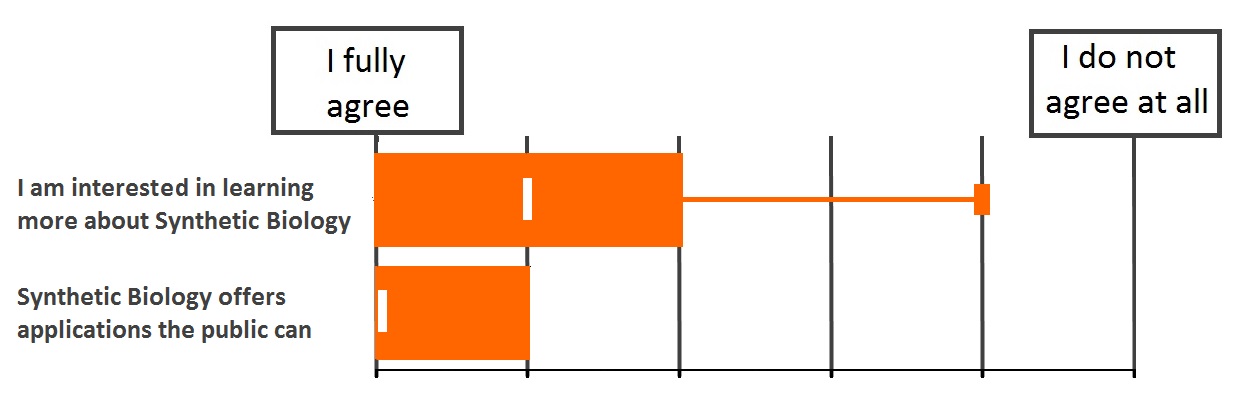
Figure 1: Results for our survey's questions regarding the public assessment of synthetic biology. Here, only the answers of interviewees who did not know about synthetic biology before the event are evaluated. The results are represented in the form of box plots. The Orange boxes mark the two inner quartiles. The Whiskers mark the 90-percent-quantiles. White rectangles indicate the position of the medians.
We were happy to find, that our interviewees do not outright reject the idea directed genetic modification and Synthetic Biology. Almost all people we talked to were quite interested in the topic and agreed that many beneficial applications are possible. This is also reflected in the results of our survey (see Figure 1).

Figure 2: Results for our survey's questions assessing people's opinion on our microbial fuel cells and where they might be employed. Here, only the answers of interviewees who did not know about Synthetic Biology before the event are evaluated. The results are represented in the form of box plots. The orange boxes mark the two inner quartiles. The whiskers mark the 90-percent-quantiles. White rectangles indicate the position of the medians.
Reactions towards our particular project were also quite positive, as visible in Figure 2. However, during the conversations, almost all the adults we spoke to expressed some concerns regarding biosafety aspects of microbial fuel cells. They wanted to know, what would happen if the genetically modified bacteria we used were to be released into the environment. This strengthened our belief that a functioning biosafety approach was of critical importance for the overall project.

Figure 3: Results for our survey's questions asking people to assess the risks of synthetic biology as well as the ethical implications . Here, only the answers of interviewees who did not know about Synthetic Biology before the event are evaluated. The results are represented in the form of box plots. The orange boxes mark the two inner quartiles. The whiskers mark the 90-percent-quantiles. White rectangles indicate the position of the medians.
As can be seen in Figure 3, feedback regarding the perceived risk as well as the ethical aspect of synthetic biology was more ambiguous. Unfortunately, almost nobody told us much about their views on these topics during conversations and we only got to see the results of the survey afterwards. For future events, it might be wise to inform about the current safety standards, government supervision and security considerations in more detail, to lessen the public skepticism towards synthetic biology. Apart from that, finding out what kind of ethical concerns people have would be a very interesting topic for a future survey.
The question whether people would use a cell phone, which has genetically organisms inside its battery is of high importance for us. It helps us assess if this type of technology would be accepted in everyday life. We were worried, because there is a general animosity against everything that has to do with genetic engineering in Germany. Surprisingly, 83.3 % of the people we asked answered that they had no concerns using such a device. Among the people who did not know about Synthetic Biology before the event the percentage was only slightly lower at 76.4 % (see Figure 4). This shows us that at least after getting informed about the subject, people are open to using microbial fuel cells in their everyday life.

Figure 5: Our interviews answers to what kind of impact the street science event had on their opinion on genetic engineering. The numbers inside the boxes show the total number of people who gave the respective answer. Nobody chose the third option, which was "Yes, I now have a more negative opinion". Only the answers of people who did not know about Synthetic Biology before the event are shown here.
Finally, we wanted to know whether our event had an impact on people's opinion on the topic of genetic engineering. Unfortunately, we were not able to do a before-and-after-survey, so we were only able to ask people after they had already talked to us. The results were satisfying: Of the people who had not heard of Synthetic Biology before the event, 60% said that they now had a more positive opinion on the subject (see Figure 5). Nobody answered that they had attained a more negative opinion after talking to us.
Conclusion
We were very happy with how the street science event turned out. We entertained and educated many children and were able to inform lots of adults about Synthetic Biology and our project and thus share our passion. In addition, the event was very educational for us as well. We were surprised to find that, at least after being informed about the project, people liked the idea of microbial fuel cells and many would even use them in their everyday lives. However, we also realized how important a thorough biosafety concept is for public acceptance, even when working with supposedly harmless BSL-1 organisms. Almost every adult we spoke to asked us about the risks of using GMOs and what would happen if the bacteria in the fuel cell were released into the environment. Most people were content when we explained what kind of biosafety approach we had planned, some still had doubts. This made us spend even more time on making the biosafety system work. We also learned to consider not only which safety-measures we as scientists deemed necessary, but what was required to achieve public acceptance.
 "
"

